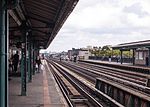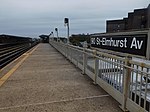Boulevard Theatre (Queens)
Boulevard Theatre was an 1,839-seat theater opened in 1926 in the Jackson Heights section of Queens, New York. It now lives on as the Boulevard Latin Cuisine restaurant . Herbert J. Krapp was the building's architect and it was part of the Grob & Knobel circuit. Designed as a playhouse it showed pre-openings headed for Broadway and shows closed out on Broadway. These attractions were shown Monday through Saturday, while vaudeville and a feature movie were shown on Sundays.It eventually became a double-feature movie house, competing with the Jackson Theatre, and was later modified into a triplex as it struggled to survive into the 1980s. It closed and was empty for a decade as neighborhood progression took hold. The owner wanted it demolished, but with community support it was eventually converted into a dinner theater venue serving the area's Hispanic community. The entrance and lobby of the theater is now a restaurant and bar, and three auditoriums in the back are used for plays, concerts, and import films.
Excerpt from the Wikipedia article Boulevard Theatre (Queens) (License: CC BY-SA 3.0, Authors).Boulevard Theatre (Queens)
Northern Boulevard, New York Queens
Geographical coordinates (GPS) Address External links Nearby Places Show on map
Geographical coordinates (GPS)
| Latitude | Longitude |
|---|---|
| N 40.75552 ° | E -73.88458 ° |
Address
Boulevard Theatre
Northern Boulevard 82-22
11372 New York, Queens
New York, United States
Open on Google Maps








